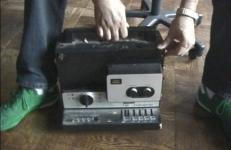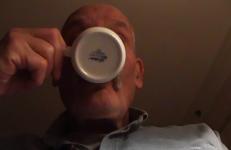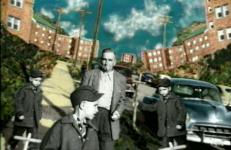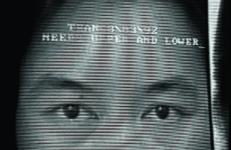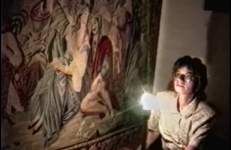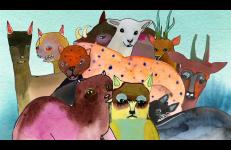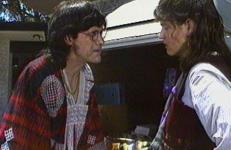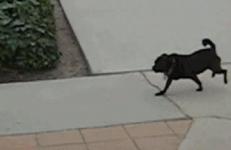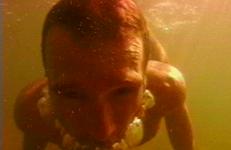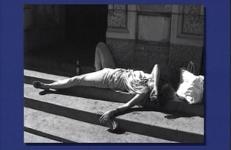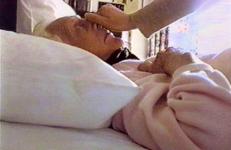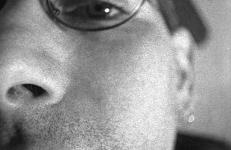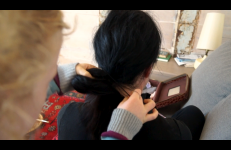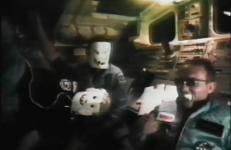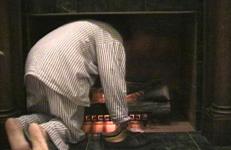This piece purports to be about the discontinuation of the much-loved format, Kodachrome, and with it the further endangerment of super-8 film. But it has other agendas of reclamation and personal reckoning that are its true subject matter.
Autobiography
A trip to Winnipeg introduces the viewer to moments of Canadian cuisine and to the easily digestible tidbits that make up the WNDX Film/Video Festival. Come join the movie buffs as they beef up on eye candy and tummy truffles, all the while indulging in a masticating miasma of minutia that's easy to swallow. Wash it all down with some river views and Mr. Coffee secretions and you'll get a taste of the treats that await all who head north to appease the more southerly rumblings of the human anatomy.
This surreal, free-form autobiography is concerned with childhood and adult rituals, and the longing for meaning and connection during the often wildly absurd events of early life. Obsessive Becoming returns to Reeves’s early exploration of personal narrative forms, poetry, and his interest in creating a more spontaneous and direct fusion between language and video. Words and images of the expectations and disappointments of coming of age break down the boundaries of both mediums.
Are gender outlaws considered the new biological terrorists seeking weapons of mass bodily destruction? OPERATION INVERT compares the different regulations mediating botox-related plastic surgery and gender reassignment "sex change." Historical medical assessments of the invert (homosexual and transsexual) "condition" reveal seemingly outdated absurdities about outsider deviance. Nonetheless, current institutional loopholes governing gender re-assignment surgery suggest a fresh resurgence of loony pathology and diagnosis.
The artist visits with seven cosmetic surgeons specializing in blepharoplasty (cosmetic eyelid creasing surgery) in the West Hollywood/Beverly Hills area for initial consultation sessions. The doctors demonstrate different reshaping options and comment upon the prevalence and success rates for different Asian nationalities while Tran presents statistics and facts in text that frame the consultations.
This title is also available on Tran, T. Kim-Trang: The Blindness Series.
In Precious Products we are subtly reminded of this country’s obsession with consumerism and narcissism. George, with his ever-present video-8 camera, attends an opening of Precious Products—an exhibition of artworks satirizing art as commodity. He leaves the art world of San Francisco to spend a Christmas holiday with friends in their opulent home. Ironically, this is the home of a celebrity (another kind of commodity), Russian defector/ballerina Natalia Makanova. Surrounded by all the luxuries of life and Makanova’s image, George muses about death.
Susan Mogul's first video diary work, produced two years before Everyday Echo Street: A Summer Diary (1993), follows the artist on a trip though Eastern Europe immediately after the fall of the USSR. Through discussions with various characters about politics, art, and each others personal lives, Mogul creates a video time capsule of social life in Poland, then Czechoslovakia, and former Yugoslavia.
How do we tell the story of a life? What cruel reduction of an image will stand (in the obituary, the family photo album, the memory of friends) for the years between a grave and a difficult birth? Public Lighting examines the current media obsession with biography, offering up “the six different kinds of personality” (the obsessive, the narcissist) as case studies and miniatures, possible examples.
Thanksgiving in California is the setting in which the viewer experiences "the depression inherent to festive occasions. There were many things bothering me at this time, or maybe it was one thing that broke into many pieces.
This title is also available on The World of George Kuchar.
Domestic life in south London filtered through stories of weight (and waiting), local history, bad dreams and the ongoing colonisation of the moon.
Original music by Bruno De Angelis.
Return to the House of Pain documents my walking through the turf and sludge of the Big Apple and many worm holes... I chomp my way back west and gnaw on all that sinks stomachward and beyond in vertiginous aching.
Steve Reinke has long been lauded for his irreverent, philosophical, and often acerbic works, which typically adopt the form of personal essays to wryly bend and reread wide-ranging topics, from pop culture, to sex, to theories of visual perception and beyond. Reinke’s video, included in the 2014 Biennial, Rib Gets in the Way, is narrated in the first person by Reinke, and addresses mortality, the body, the archive, and the embodiment of a life’s work.
“The Riot Tapes is a video biography of Segalove’s political involvement in college, of her boyfriend (who became anorexic while dieting to evade the draft), and of her discovery that art could give her a voice and a forum for her political views. It is her first real political work. Segalove says, ‘I’m trying to comment on the state of things. A lot of my peers spend a lot of time in a state of disbelief, but I’m tired of disengaging myself from the world by doing that.’”
—Gloria Ohland, “Segalove’s Latest Is a Riot,” L.A. Weekly 6:22 (27 April 1984)
This title is only available on Kip Fulbeck Selected Videos: Volume One.
“Living in Los Angeles is like being on vacation, or in a coma. I don’t really like it, but it’s so pleasant I don’t want to leave. I’ve only had one idea since I’ve been here and that was to video a cake in the rain in MacArthur Park. But it’s only rained once, briefly in the night, and I was asleep, and dreaming of snow.” —Steve Reinke
Sea In The Blood is a personal documentary about living with illness, tracing the relationship of the artist to thalassemia in his sister Nan, and AIDS in his partner Tim. At the core of the piece are two trips. The first is in 1962, when Richard went from Trinidad to England with Nan to see a famous hematologist interested in her unusual case. The second is in 1977 when Richard and Tim made the counterculture pilgrimage from Europe to Asia. The relationship with Tim blossomed, but Nan died before their return.
This tape addresses spiritual closure. Video gave me a chance to examine, see, and celebrate the seven spiritual venues, paths, and journeys that I have made: 1) Catholic life, 2) nun's life, 3) yoga life, 4) Buddhist life, 5) feminist life, 6) natural life, 7) life. Publicly, I am admitting that I am a spiritual materialist—been there, done that—but I am also saying that all of my spiritual experiences have worked together to prepare me for even deeper journeys combining all of the sacred technologies I have learned so that I can re-invent my own way.
This tape functions on two levels. Montano addresses menopause and acts out her worst nightmares around that issue—playing the out-of-control, alcoholic crone. By doing this publicly on tape, she felt that she could look at, share and make friends with, her concerns with aging. The experience of viewing this video moves from an autobiographical look at Montano’s process to an interactive game for the viewer.
Shifting Positions is a semi-autobiographical/fictional trilogy exploring becoming queer later in life, my father's dementia, and our mid- and end-of-life crises. The selling of our family home of forty years prompted the making of the first section, entitled 'Last Home', which investigates the ways memories and spirits inhabit a house. In the remaining two sections— 'Napping' and 'Behavior Of Fascination'—the relationship between father and daugther is looked at through 'home movies' and documented intimate moments of private life. —Kathy High
"Look at a landscape and imagine a different one there. Touch the body and let it slip from memory. Imagine a desert when what you see is winter. The filmmaker evokes a territory where fragile shifts—the links between things, emotions, and places—materialize and dematerialize."
—Nicole Gingras
This title is also available on Nelson Henricks Videoworks: Volume 1.
A collision of separate pasts, this film pieces together fragments of the director's own images and text from a 1991 visit to the East German town of Halle with those produced by Bauhaus painter Lyonel Feininger in 1931. A meditation on emotional memory, the film interrogates the ability of images to document personal history.
This latest work from the ReStack’s pulls the experience of becoming mother (both through fostering and bio) through the lens of personal lives that are always, also, steeped in a world where systemic racism, classism and heteronormativity influence and shape.
This latest work from the ReStack’s pulls the experience of becoming mother (both through fostering and bio) through the lens of personal lives that are always, also, steeped in a world where systemic racism, classism and heteronormativity influence and shape.
Space Ghost compares the experiences of astronauts and prisoners, using popular depictions of space travel to illustrate the physical and existential aspects of incarceration: sensory deprivation, the perception of time as chaotic and indistinguishable, the displacement of losing face-to-face contact, and the sense of existing in a different but parallel universe with family and loved ones.
Physical comparisons such as the close living quarters, the intensity of the immediate environment, and sensory deprivation, soon give way to psychological ones: the isolation, the changing sense of time, and the experience of earth as distant, inaccessible, and desirable. The analogy extends to media representations that hold astronauts and prisoners in an inverse relationship: the super citizen vs. the super-predator. Astronauts, ceaselessly publicized, are frozen in time and memory whereas prisoners, anonymous and ignored, age without being remembered.
Blind man: “It is bad to be alone.”
The Creature: “Alone, bad.”
—The Bride of Frankenstein
It can be so bad to be alone that even an artificial heat is better than none.
This title is also available on Ximena Cuevas: El Mundo del Silencio (The Silent World) and Half-Lies: The Videoworks of Ximena Cuevas.




